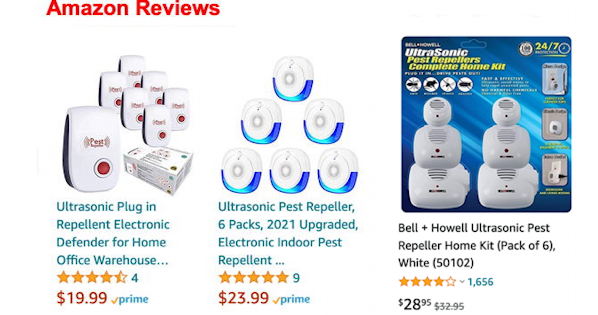People can hear sounds ranging from 20 to 20,000 cycles per second 20 kHz (KiloHertz).
Cats can hear up to 60 kHz. Dogs can pick up sounds up to 40 kHz.
Pet rats, mice, hamsters, guinea pigs and other pet rodents can hear sounds up to 90 kHz.
Ultrasound can repel rodents (mice and rats) by subjecting them to intense auditory stress.
Hamsters, guinea pigs, gerbils, and chinchillas are all potential family pets and all members of the rodent family, so you should not use ultrasonic pest repellers around them.
Most of the manufacturers of ultrasonic pest repellents claim that their products dont have any harmful effects on dogs and cats. It has an element of truth since high frequencies on their own dont make dogs uncomfortable, although they can hear them.
Some humans can detect frequencies as high as 22 kHz. See side affects for humans in technical article below.

The Bell + Howell we got uses frequencies from 22-65 KHz.
Most of these devices use frequencies of 32KHz and above.
There is a controversy over whether these work.
Ultrasonic Pest Repellers: Solution or Scam? at the International Association of Certified Home Inspectors (InterNACHI) says,
"Manufacturers of ultrasonic pest repellers make claims that may be unsupported by scientific testing. In fact, more than 60 companies received warning letters from the FTC in 2001 stating that efficacy claims about those products must be supported by scientific evidence." Two years later, one company was sued by the FTC for violating its warning.
One extensive test performed by Kansas State University in 2002 found that the devices were effective at repelling some insects, such as crickets, but the same devices had little effect on cockroaches. Ants and spiders were unaffected by any of the devices. Of the pests that seem to be bothered by the noise, some tests have shown that they soon become habituated as they realize the noise is harmless."

Proof That Ultrasonic Pest Repellers Are A Scam: Class Action Lawsuit against Bell+Howell For Fraud. Mousetrap Monday. - YouTube, which tested another brand.
Bell + Howell settled the class action without admitting fault, but offering refunds to anyone who had one.
A review at PestRepellerCenter.com/ says Bell and Howell can repel "mice, roaches, spiders, ants, and even gnats, this device is mostly used in terrariums but also functions well in small to medium-sized homes and offices."
From a review of Bell&Howell at Amazon

An amazon review of another model said several members of her family got headaches with it.
We put 10 of these in our cabin and I got a headache in 24 hours .

They also say the Bell + Howell has the most misleading advertising and has had a class action law suit filed against it.
4 Types of Insect Repellent to Skip - Consumer Reports
The FTC has investigated several sonic repellent makers for false advertising.
5 Best Ultrasonic Pest Repellers - Mar. 2021 - BestReviews
Its important to note that this type of device is not effective against all pests. Certain insects, like ants, are more resilient than others when it comes to ultrasonic frequencies. Some studies have also shown that ultrasonic repellers may even attract critters (such as mosquitos) into your dwelling. Correct positioning and use of these units is the best way to maximize effectiveness, but dont think of it as an instant solution to pest problems. It takes time for repellers of this type to produce a measurable effect.
Do Ultrasonic Pest Repellers Really Work? | Terminix
While some ultrasonic repellents may have a minor short-term impact on some pests, the research is nearly universal: Ultrasonic pest repellers are not an effective
Ultrasonic Pest Repellers: Solution or Scam? - InterNACHI®
One extensive test performed by Kansas State University in 2002 found that the devices were effective at repelling some insects, such as crickets, but the same devices had little effect on cockroaches. Ants and spiders were unaffected by any of the devices.
Even models proven successful in tests are unlikely to perform adequately in real-world situations, where signal strength rapidly diminishes.
Safety concerns have arisen, too; some users have reported that the sound can weaken the clarity of telephone conversations, interfere with burglar alarm systems, and cause muting in hearing aids.
InterNACHI® is the worlds leading association for home inspectors. We provide free training, online testing and certification.
Affect on humans: some of whom can hear frequencies up to 22 kHz.
PubMed Central, Proc Math Phys Eng Sci. 2016 Jan; | ncbi/nih.gov
Brief overview:
This paper presents new measurements that demonstrate human exposure to airborne ultrasound in public places, including railway stations, museums, libraries, schools and sports stadia. It argues that the guidelines for protecting humans from airborne ultrasound vary and are uniformly inadequate: for energy above 22.4kHz, they are based on avoiding ultrasonically induced hearing damage at the lower frequencies used to understand speech, taking no account of reports of the ability of airborne ultrasound in occupational settings to cause nausea, dizziness, tinnitus, fatigue, migraine and headaches.
Research has shown that airborne ultrasound has the potential to cause nausea, fatigue, and headaches [3],[7],[8],[20],[43],[50] [34].
7. Damongeot A, Andr G. 1988. Noise from ultrasonic welding machines: risks and prevention. Appl. Acoust. 25, 4966. (doi:10.1016/0003-682X(88)90112-0) [Google Scholar]
8. Von Gierke HE, Nixon CW. 1992. Damage risk criteria for hearing and human body vibration. In Noise and vibration control engineering: principles and applications, pp. 598600. New York, NY: John Wiley and Sons. [Google Scholar]
20. International Non-Ionizing Radiation Committee of the International Radiation Protection Association. (INIRC-IRPA). 1984. Interim guidelines on the limits of human exposure to airborne ultrasound. Health Phys. 46, 969974. (doi:10.1016/0041-624X(76)90074-3) [PubMed] [Google Scholar]
43. National Occupational Health and Safety Commission (NOHSC). 2002.